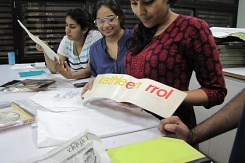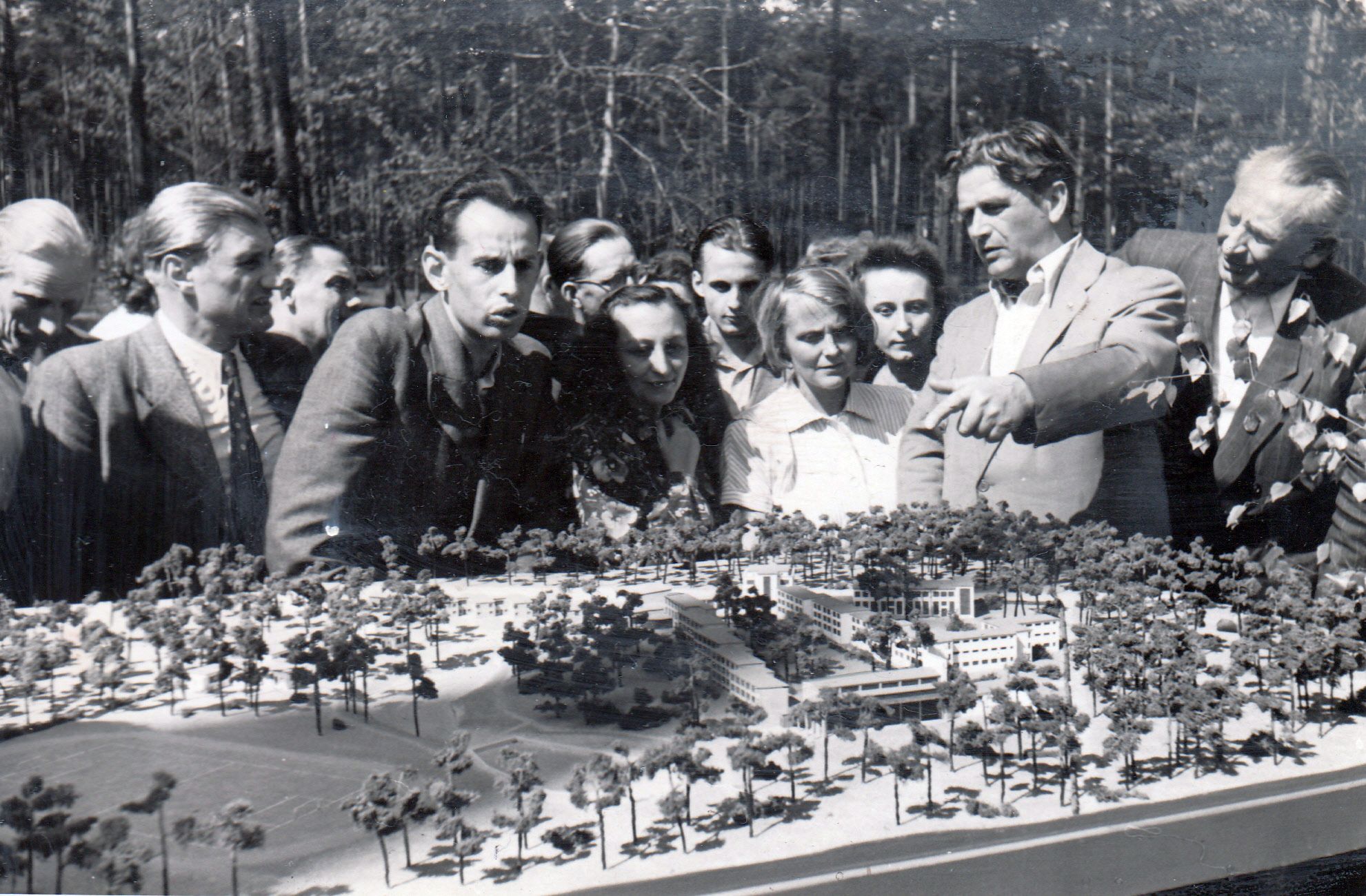Im Sommer 1965 überschnitten sich die Ereignisse: Während der Design-Student Sudhakar Nadkarni an der Hochschule für Gestaltung Ulm (HfG) an seiner Diplomarbeit zur Gestaltung eines Milchkiosks für seine Heimatstadt, die Millionenmetropole Bombay, arbeitete, reiste der deutsche Architekt und Designer Hans Gugelot an das 1961 gegründete National Institute of Design (NID) in Ahmedabad, um dort einen Sommerkurs zu unterrichten. Er gehörte zu einem Kreis von eingeladenen Fachberatern. Man hatte ihm die Entwicklung einer Ventilator-Serie für Haushaltszwecke sowie einer preiswerten Möbelserie angetragen. Der „Tangential Fan“, der in diesem Sommer gemeinsam mit indischen Studierenden erarbeitet wurde, war Teil des Auftrags. Neben Gugelot hatte das NID eine Reihe von internationalen Fachleuten verpflichtet, den Aufbau der ersten modernen Gestaltungsschule in Indien zu unterstützen: etwa Charles und Ray Eames, Alexander Girard, Louis Kahn, George Nakashima, Claude Stoller und andere. Deren Beratungstätigkeit wurde großzügig von der amerikanischen Ford Foundation gefördert, die bereits das von Premierminister Jawaharlal Nehru beauftragte Gutachten zur Entwicklung einer modernen Designschule – den India Report (1958) – finanziert hatte, ein Dokument, das heute zum Gründungsnarrativ des NID gehört.
Nadkarni stammte aus einer indischen Mittelklassefamilie und studierte an der Sir J. J. Institute of Applied Art Bombay angewandte Kunst. Die Profession des Industriedesigners bildete sich in Indien damals gerade erst heraus. In seinen Erinnerungen berichtet Nadkarni, wie er durch einen Vortrag des britischen Designers James Gardner zum ersten Mal auf das Berufsfeld des Industrial Design aufmerksam wurde. Von der HfG Ulm erfuhr Nadkarni durch den indischen Designer Yeshwant Chaudhary, der ebenfalls Absolvent des Sir J.J. Institute of Applied Art in Bombay und der Central School of Art and Crafts London war. Dieser schrieb ihm dann auch eine Empfehlung für die HfG.1
Dass gerade die Gestaltung moderner Gebrauchsgüter ein so faszinierendes Berufsfeld für die junge Generation der indischen Mittelklasse darstellte, ist nur vor dem Hintergrund der umfassenden kulturellen und wirtschaftlichen Veränderungen verständlich, die der erste Präsident des jungen unabhängigen Indiens, Jawaharlal Nehru, mit seiner Modernisierungsagenda angestoßen hatte. Umfangreiche Infrastrukturprojekte, der Ausbau der Großindustrie, die Förderung moderner Bildungseinrichtungen – all dies war Teil der staatlichen Fünfjahrespl.ne, mit denen das moderne Indien seine koloniale Vergangenheit hinter sich lassen wollte. Moderne Architektur und Design waren nicht nur Symbolträger dieses Wandels, sondern selbst Agenten zur Einübung einer modernen Lebensweise.
1962 war Nadkarni nach Ulm gereist, um unter anderem bei Hans Gugelot Produktdesign zu studieren. Dort begegnete er auch Kumar Vyas von der Central School of Art and Crafts in London, der für sechs Monate nach Ulm kam. Beide formten später den Lehrkörper für die Produktdesignerausbildung am NID. Der indische Student erlebte die HfG bereits als einen Ort, der konsequent auf eine am Zusammenwirken von Wissenschaft, Technik und Industrie ausgerichtete Gestaltungslehre orientiert war.
Von Beginn an war die HfG eine für die Nachkriegsmoderne exemplarische Plattform der Vernetzung und des internationalen Austauschs. Die Liste der Lehrkräfte liest sich wie das Who is Who der internationalen Architektur- und Designszene: Reyner Banham, Charles und Ray Eames, Buckminster Fuller, Abraham Moles, Norbert Wiener und andere.
Auch wenn die HfG Ulm als legitime Nachfolgeinstitution des Bauhaus gilt, ging der Argentinier Tomás Maldonado, der 1964–1966 Rektor der Schule war, auf Abstand zur Agenda seines Vorgängers – des Schweizer Architekten und ehemaligen Bauhaus-Schülers Max Bill. Bill hatte Maldonado, den Vertreter der geometrischen Abstraktion, der 1944 in Buenos Aires die Vereinigung Arte Concreto Invención gegründet hatte, nach Ulm eingeladen. Tatsächlich bildete sich im damaligen Verhältnis der Hochschule für Gestaltung zum historischen Bauhaus auch die kulturelle und politische Gemengelage Nachkriegsdeutschlands ab: Die HfG – zunächst als nichtstaatliche Bildungseinrichtung gefördert vom Re-Education Fund der Amerikaner – trat mit Gründungsfiguren wie Inge Scholl, der Schwester der von den Nationalsozialisten ermordeten Geschwister Scholl, konsequent für eine explizit politische demokratische Bildung ein. Das Erbe des Nationalsozialismus auf der einen Seite, die Kritik an der Faszination für die amerikanische Konsumgesellschaft im Nachkriegsdeutschland auf der anderen Seite – Inge Scholl sprach vom „Nierentisch Alptraum“ – diese beiden Pole formten das Spannungsfeld. Innerhalb diesem rang die außergewöhnliche Schule auf dem Kuhberg um eine Haltung zum modernen Design. Wenn auch für Bill genuine soziale und kulturelle Reformen mit einer Veränderung der Formgebungen der sozialen Umwelt, der Architektur des Designs der Gegenstände des Alltags beginnen mussten, blieb die Auseinandersetzung darum, inwiefern gestaltete Produkte „kulturelle Güter“ oder wissenschaftlich begründete Gebrauchsgegenstände unterschiedlichen Komplexitätsgrades seien, dauerhafter Gegenstand der Campusdebatten.2
Während in den Gründungsjahren der HfG noch ehemalige Bauhäusler wie Josef Albers, Helene Nonné-Schmidt und Walter Peterhans unterrichteten, schienen die in der Arts-&-Crafts-Tradition verankerten pädagogischen Prinzipien des historischen Bauhaus den Studenten kein adäquates Wissen mehr für den Umgang mit der industriellen Entwicklung in der Nachkriegsära bereitstellen zu können. Maldonado lehnte Bills Bauhaus- und Werkbund-Idealismus – die Idee der „guten Form“ – rigoros ab. Er ging auf Abstand zu dem im Nachkriegsdeutschland favorisierten Narrativ des expressionistischen Bauhaus als einem vom Nationalsozialismus nicht kontaminierten Erbe humanistischer bürgerlicher Kultur. Seine in der hauseigenen Zeitschrift ulm 1963 veröffentlichte Streitschrift „Ist das Bauhaus noch aktuell?“ formuliert, um welches Bauhaus-Erbe es in Ulm gehen sollte: das an wissenschaftlicher Rationalität ausgerichtete Bauhaus unter der Direktorenschaft Hannes Meyers.3 Maldonado plädierte für eine säkularisierte, in den Prinzipien rationaler Produktion verankerte und vom expressionistischen Künstlerethos befreite Designmethode:4 Im Kern ging es in diesen Bauhaus-Nachkriegsdebatten um eine Neubestimmung des Verhältnisses zwischen Design und Gesellschaft. Auch Sudhakar Nadkarni, der zu den Modernisierungsprozessen seines Landes einen Beitrag leisten wollte, war von dieser eminent gesellschaftlichen Rolle des Designers überzeugt.
Schon Nadkarnis Diplomthema „Die Gestaltung eines Milchkiosk“ ist Ausweis dieses sozialen Bewusstseins und seines Wunsches, einen Beitrag zur Befriedigung der existenziellen Bedürfnisse der indischen Bevölkerung leisten zu wollen. Seine Diplomarbeit besteht aus zwei Teilen, einer wissenschaftlichen Analyse und dem Entwurf. Im ersten Teil führt der Autor in die Aufgabenstellung ein, er hinterfragt, warum die Verbesserung des Systems der Milchdistribution in den großen Metropolen Indiens so bedeutsam ist. Fünf Jahre nach der Unabhängigkeit Indiens (1947) war die erste staatliche Molkerei in Bombay nach modernsten hygienischen Anforderungen entstanden, um die Milchversorgung als Baustein einer gesunden Ernährung für 1,5 Millionen Menschen zu sichern. Ein Großprojekt, das auch die Unterstützung durch die UNICEF erhielt. Die Milch wurde dabei von der modernen Molkereianlage in kleinere Verteilzentren geliefert, die den Verkauf organisierten. Für dieses System entwirft Nadkarni einen Kiosk, der den Prozess der Lieferung und Verteilung verbessern soll. Seine Idee besteht darin, eine modulare Struktur zu entwickeln, dafür zieht er zunächst internationale Beispiele vorgefertigter Kioske, Bushaltestellen und Pavillons heran. In einem komplexen Diagramm visualisiert er dafür die einzelnen Schritte der Analyse, die zum Verständnis des Systems der Milchdistribution notwendig sind. Er analysiert die Umgebung der Milchkioske, ihre Lage im Stadtraum, im Verkehr, innerhalb der Wohngebiete und innerhalb der städtischen Infrastruktur. Im nächsten Schritt beschreibt er die sozialen Hintergründe der Verbraucher sowie die Arbeitsabläufe eines solchen Verteilungszentrums. Von indischen Kollegen in Bombay durchgeführte Befragungen auf der Basis von Fragebögen von über 40 Milchkioskbetreibern und Nutzern sowie eine Recherche zu den klimatischen Verhältnissen und Bewegungsabläufen im Kiosk ergänzen seine Untersuchungen.5 Diese Ergebnisse bilden die Grundlage für den Entwurf des Milchkiosks. Das verwendete Material ist kostengünstig, weil es modular standardisiert, haltbar und in Indien vorhanden ist, die Größe der Kioske ist auf zwei arbeitende Menschen ausgerichtet. Funktionale, ergonomische, aber auch klimatische Aspekte werden im Entwurf berücksichtigt. Seine weiße Farbgebung reagiert auf die klimatischen Bedingungen und die hygienischen Anforderungen. Der einfache Schriftzug „Milch“ kommuniziert die Funktion des Objekts.
Auch wenn der Kiosk ein Prototyp geblieben ist, ist diese Abschlussarbeit ein aufschlussreiches Dokument der Ulmer Methode, die auf dem systematischen Herangehen an eine Designaufgabe sowie in der wissenschaftlichen Analyse der jeweiligen Gestaltungsschritte gründet.6 Nadkarnis Diplom bietet zudem einen unmittelbaren Einblick in die sozialen Umstände und materiellen Konditionen des jungen unabhängigen Indiens der 1960er-Jahre. Die Infrastruktur der täglichen Milchversorgung in der Millionenmetropole war ein Fundament, um die Grundbedürfnisse der Bewohner zu befriedigen. Sowohl auf dem Kuhberg in Ulm wie in Ahmedabad war man überzeugt, dass nur ein rational begründetes Design, das sich mit den grundlegenden Systemen der Gesellschaft, der Infrastruktur, der Gesundheits- und Nahrungsmittelversorgung befasst, die unmittelbaren Bedürfnisse der Menschen ernst nehmen kann. Der Milchkiosk-Entwurf ist ein herausragendes Dokument einer Gestaltungshaltung, die Design als ein Mittel zur Verbesserung des Alltags begreift.























.jpg?w=245&h=163&c=1)








.jpg?w=245&h=163&c=1)












